Official Standard of Excellence for American Pasture Pigs
Breeding to a standard is the process of intentionally selecting animals that meet or exceed a defined set of ideal traits to improve a breed’s quality, consistency, and functionality over time. This method ensures that each successive generation aligns more closely with the breed’s purpose and desired characteristics. For the American Pasture Pig, breeding to the APPS Standard of Excellence focuses on traits that enhance health, productivity, and adaptability in pasture-based systems.
The process begins with evaluating potential breeding animals against the standard. Only those that meet the criteria, such as proper conformation, mobility, reproductive soundness, and temperament, are selected. Breeders also consider performance records, such as growth rates, number of piglets weaned, carcass quality, and feed efficiency, to ensure the animals not only look the part but also perform effectively in pasture conditions.
Once breeding pairs are chosen, their offspring are assessed to determine if they meet the standard. This assessment includes observing physical traits, monitoring behavior, and evaluating health and productivity. Animals that consistently pass these traits on to their offspring over several generations establish strong, reliable lines that exemplify the breed’s ideal traits.
Breeding to a standard is not just about eliminating undesirable traits but also about enhancing positive ones. For example, selecting pigs with strong legs and feet ensures they can navigate diverse terrains, while choosing those with robust reproductive traits supports long-term herd sustainability. Over time, breeding to a standard creates a uniform and dependable breed that fulfills its intended purpose while maintaining genetic diversity and adaptability.
By adhering to a clear standard, APPS-Registered Breeders contribute to the ongoing improvement and development of the APP breed, ensuring its value and success in profitable, pasture-based farming systems for years to come.
-

Head, Neck, & Ears
The ideal head for an American Pasture Pig (APP) should be proportionate to the body, ensuring balance and functionality. The forehead should be flat and upright when viewed from the side, contributing to the breed’s robust, alert appearance. The snout should be wide, short to medium in length, with a moderate upturn and well-defined wrinkles. Eyes should be large, bright, and set wide apart, symmetrical, and indicative of good health. Nostrils must be large and symmetrical, and the jowl should be broad and smooth, free from flabbiness.
The neck must be well-muscled, thick, and in proportion to the body to support grazing and overall movement. It should flow seamlessly from the head to the shoulders without noticeable dips or disruptions, aiding the pig’s ability to feed and interact with its environment.
Erect ears are an important feature for the breed. Set wide apart at the top corners of the head, they should be symmetrical in form and attachment, slightly pointed, and of moderate thickness. Erect ears not only contribute to the breed’s characteristic appearance but also serve a functional purpose in regulating body temperature. By standing upright, the ears help to maximize airflow around the pig’s head, which is essential for heat dissipation. This trait better allows APPs to stay cool in warmer environments by enabling more efficient heat release from the body, especially important during the summer months.
Objections: Heads that are disproportionate to the body, such as those that are too large or too small, are undesirable. Eyes should be large, bright, and symmetrical. Any signs of asymmetry or dull eyes are considered faults. The snout must not be too long, narrow, or short, and should always include the characteristic wrinkles and upturn. The neck should be well-proportioned, thick, and free from malformations. Ears that are not symmetrical in size, shape, or attachment, or are completely folded or flopped over, fail to meet the breed standard. Additionally, any health concerns, such as breathing difficulties or blindness, disqualify the APP from registration.
(Approved by the APPS on 1/1/25)
-

Body & Topline
The ideal body structure of an American Pasture Pig (APP) is designed to meet the physical demands of sustainable, pasture-based farming systems. APPs should display a balanced, athletic, and efficient build that maintains evenly distributed width from shoulders to hams. The body should appear symmetrical and proportional from all angles, with a harmonious relationship between depth, length, and width that ensures both functionality and durability.
The depth from the topline to the underline must be sufficient to house and protect vital organs, supporting reproduction and digestion. The ribcage should be deep, expansive, and slightly loose to provide optimal lung capacity and digestive efficiency. The body should be long in length, emphasizing muscularity without compromising functionality. This length supports efficient movement, enhances stride, and allows the pig to cover more ground while foraging. Firm, well-muscled loins are crucial for strength and endurance, while the shoulders and hams must be wide and substantial, contributing to the overall durability and productivity of the animal. The underline should remain smooth and straight, with a slight natural curve that complements the body’s flow and structure.
A straight, strong, yet flexible topline is fundamental to the APPs structure and performance. The topline, which runs from the base of the neck to the tailhead, should exhibit strength without rigidity, ensuring balance, proper weight distribution, and smooth, efficient movement. A strong topline also reduces strain on the joints, enhances mobility, and supports the durability and longevity required for thriving in pasture-based systems. Combined with an athletic, long-bodied frame, these characteristics enable APPs to handle the physical demands of rotational grazing while maintaining productivity and adaptability.
Objections: APPs that lack sufficient length often appear compact or stubby, which can limit efficiency in movement and overall functionality. Insufficient depth from the topline to the underline compromises the ability to house vital organs and support reproduction or digestion. Narrow, shallow, or tightly sprung ribs reduce lung capacity and digestive efficiency, while weak, uneven, or excessively arched toplines disrupt balance and mobility. Flabby sides, weak loins, or poorly muscled shoulders and hams detract from the APPs durability and strength. Excessively long and weak backs compromise structural integrity and endurance, hindering the pig’s ability to perform in pasture-based systems.
Such deficiencies interfere with the APPs ability to meet the rigorous physical and functional demands of pasture-based farming, limiting its adaptability, productivity, and overall efficiency.
(Approved by the APPS on 1/1/25)
-

Shoulders & Chest
The shoulders and chest of the American Pasture Pig (APP) are essential traits contributing to the breed’s mobility, strength, and efficiency in sustainable, pasture-based farming systems. These characteristics significantly impact the APPs ability to traverse grazing areas efficiently, enhancing its productivity while maintaining good health. A properly developed shoulder and chest structure not only supports overall stamina, but also plays a role in the farm’s profitability by reducing reliance on supplemental feed.
Shoulders should be broad, deep, and well-muscled, blending smoothly between the neck and topline. This conformation allows the pig to move freely and efficiently through pastureland, optimizing its grazing ability and minimizing the need for additional feed. Strong shoulders also contribute to the overall stability and balance of the animal, reducing strain on its legs and joints, which are critical for maintaining mobility in pasture systems. Efficient grazing contributes to reduced feed costs, aligning with the goal of sustainability and profitability in farming.
Chest development is equally vital. The chest should be large, full, deep, and broad, providing adequate capacity for vital organs, which is important for optimal cardiovascular function and overall stamina. A well-developed chest enhances the APPs ability to stay active and graze for extended periods, supporting its ability to work within a pasture-based system. Strong chest development also helps in reducing reliance on supplemental feed by enabling the pig to better utilize pasture resources, contributing to the long-term profitability of the operation.
Objections: Shoulders that are small, thin, or shallow, or that protrude above or dip below the topline, reduce the pig’s ability to move efficiently, which can increase reliance on supplemental feed and negatively affect profitability. Excessive shields in mature boars may cause weakness in leg conformation, limiting mobility and grazing efficiency.
Chests that are shallow or narrow restrict organ capacity and stamina, leading to decreased grazing activity and further dependence on supplemental feed. These issues can reduce growth rates, undermine overall productivity, and increase operational costs.
Overall, ensuring well-developed shoulders and chest supports an APPs ability to traverse grazing areas efficiently, promoting a healthier, more productive animal and enhancing the sustainability and profitability of pasture-based systems.
(Approved by the APPS on 1/1/25)
-

Hams & Rump
The hams and rump are critical to the American Pasture Pig (APP) in terms of functionality, mobility, and meat quality. These traits are essential for performance in sustainable, pasture-based farming systems, where grazing and foraging are key components.
Hams: The ideal hams should be large, solid, and well-muscled. They must be deep and wide, proportional to the shoulders and body, ensuring balance and symmetry. Full development from the loin to the hock is necessary for mobility and the ability to thrive in a pasture-based system. This helps support sustainable grazing practices and improves overall profitability.
Rump: The rump should be filled out well around the tail, with a straight line from the base of the tail down to the dew claws. It may have a slight slope from the loin to the base of the tail. The tail should be well-attached with a thick root, and a tightly curled tail indicating good health. This conformation ensures efficient movement and supports fluid motion, helping the pig navigate pasture effectively.
Objections: Hams that are small, shallow, or lack depth negatively affect mobility, grazing efficiency, and overall animal performance, which reduces profitability. Hams that protrude above or dip below the topline disrupt balance, hindering movement.
A low tail set or an excessively steep rump can cause joint stress, limiting mobility and leading to potential health issues, including arthritis. These conformation faults also increase the risk of breeding complications in sows, as poorly positioned pelvises may cause farrowing issues.
A limp or poorly attached tail could signal health problems, such as muscling or nerve issues, which affect overall vitality and movement. This can impact farm profitability due to reduced productivity and lower livestock quality.
In summary, the proper development of the hams and rump is essential for the APPs ability to perform well in a pasture-based system. Ideal conformation contributes to mobility, efficient grazing, and muscle development, ultimately benefiting health of APPs and farm profitability.
(Approved by the APPS on 1/1/25)
-
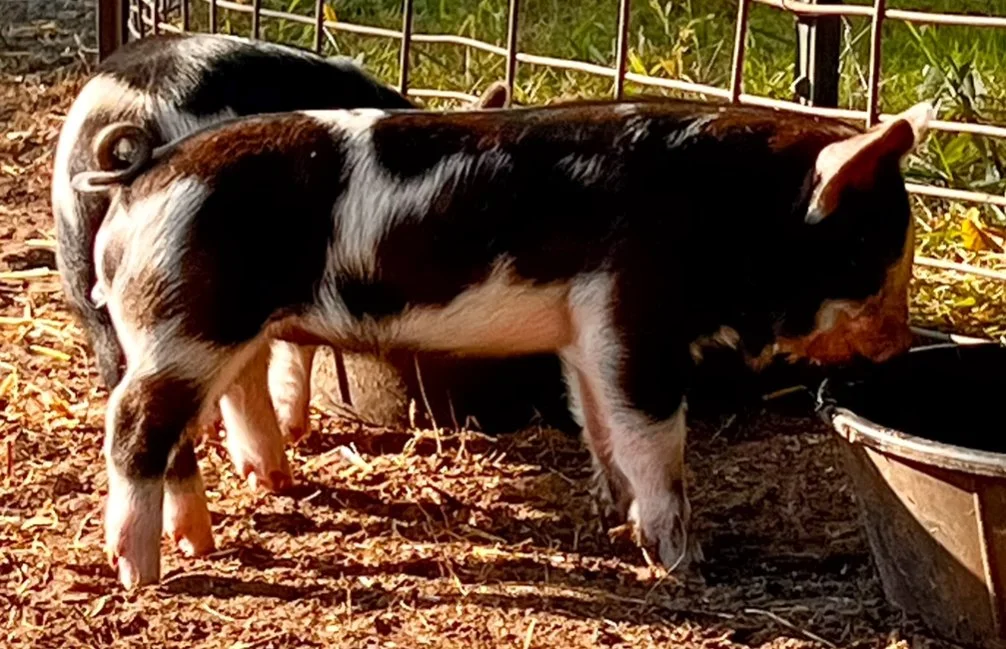
Legs & Feet
Leg and foot structure is critical to the health, mobility, and productivity of the American Pasture Pig (APP). In a pasture-based farming system, where pigs must navigate varied terrains, strong legs and durable feet are essential for efficient grazing, movement, and long-term functionality.
Ideal Structure: Legs should have thick, straight bones that provide robust support for the pig’s weight during daily activities. This is especially important for sows and gilts, who must also withstand the weight of the boar during mating. Legs must be wide-set at all four corners of the body to ensure balanced weight distribution. When viewed from the front, the legs should come straight down from the shoulder, promoting even weight-bearing and reducing strain on the joints. Strong joints enhance durability and allow for long-term mobility. The legs should show straight alignment when viewed from the front or back. Moderate leg length is ideal—long enough to facilitate efficient movement and proper clearance without being excessively tall, often referred to as “Racy.”
For sows, legs must provide adequate clearance between the underline and the ground, particularly in late gestation, to prevent injury and ensure mobility. For boars, proper leg length aids in breeding efficiency, allowing optimal positioning and reducing strain.
Feet should have tough, durable hooves capable of withstanding rough terrain without cracking or splitting. Toes must be evenly sized, straight, and point forward, ensuring stability and proper alignment. Well-formed pasterns with a slight slope absorb movement impact and reduce joint stress. The overall foot structure should be compact and symmetrical to support natural movement and even weight distribution. Dew claws should remain well off the ground to prevent injury or lameness.
Poor Structure: Thin, weak bones that cannot support the pig’s weight lead to stress injuries or deformities. Misaligned legs, such as post-legged hind legs that lack angulation, knock-kneed legs where the knees angle inward, or pigeon-toed legs with inward-pointing feet, cause uneven weight distribution, joint stress, and compromised movement. Legs that are too short or excessively long can impact mobility, breeding efficiency, and joint health.
Feet with splayed toes that spread apart are unstable and make movement difficult on uneven surfaces. Twisted or crooked toes hinder natural movement and increase the risk of injury. Uneven toe sizes cause discomfort and poor weight distribution. Hoof defects, such as cracks, splitting, or overly soft hooves, leave the pig vulnerable to injury. Flat pasterns with no slope fail to absorb movement impact, placing undue stress on the joints, while stiff pasterns restrict movement and cause premature joint wear. Low-hanging dew claws that drag on firm ground increase the risk of injury and lameness.
Objections: Deviations from the ideal leg and foot structure are unacceptable for registration with the American Pasture Pig Society (APPS). Legs that are excessively short or long, thin, weak, or misaligned, such as post-legged, knock-kneed, or pigeon-toed structures, are disqualifying, as they fail to adequately support the pig’s weight and impair mobility. Feet with significant structural flaws, including splayed, crooked, twisted, or uneven-sized toes, are also not permissible. Stiff or flat pasterns that hinder movement and place undue stress on joints, as well as excessively long or low-hanging dew claws that increase injury risks, are additional grounds for exclusion from registration.
Hoof Trimming: Hoof trimming should not be necessary for pigs that meet the APPS Standard of Excellence. If trimming is required, poor structure is likely. It may also indicate underlying issues such as poor living conditions, inadequate nutrition, excessive vitamins/minerals in their diet, or congenital defects. Addressing these factors is essential for maintaining the overall health and mobility of APPs.
By adhering to these standards, the APP can thrive in diverse and demanding environments, ensuring long-term productivity and sustainability in pasture-based systems.
(Approved by the APPS on 1/1/25)
-
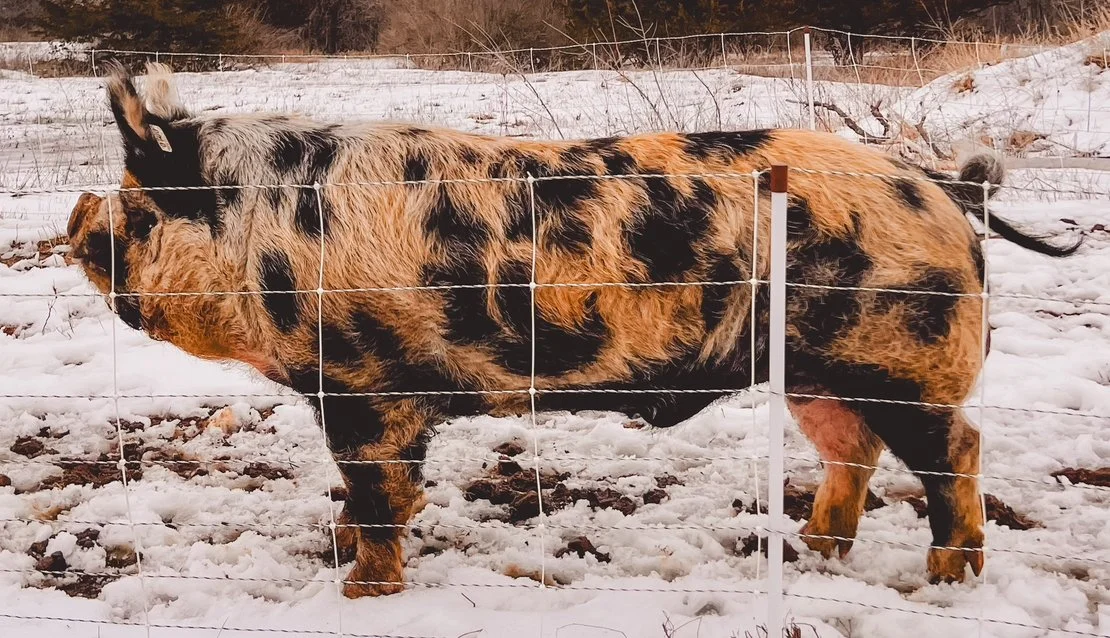
Color, Coat, & Skin
The APP can be any color or pattern, with no specific preference or requirement. The dominant color comes first, followed by the secondary color.
Current recognized colors include; black/white, white/black, ginger/black, black/ginger, brown/white, white/brown, ginger/white, white/ginger, ginger/brown, brown/ginger, tri-colored, quad-colored, black, cream, brown, and ginger.
-Agouti striping is common and often fades with age.
-As they age, brown often looks black.
-White is a true white NOT cream.
The coat should be medium to coarse in texture, providing natural protection from the elements and insects. APPs come in a wide range of colors, with no preference for any specific pattern or shade. The coat should be dense enough to provide insulation against cold and wet weather conditions. Shedding is typical during seasonal changes, however the coat should be well-maintained with no indication of excessive bald patches or poor conditioning otherwise. The skin of the APP must be dark pigmented to eliminate the risk of sunburn, especially during periods of prolonged sun exposure.
Objections: the coat should not be excessively fine or soft, as this may indicate a lack of hardiness in outdoor conditions. Coats that are patchy, thin, or lacking in coverage may be considered undesirable as they do not meet the breed’s standards for natural resilience.
(Approved by the APPS on 1/1/25)
-

Mature Size & Growth
The American Pasture Pig (APP) is a medium-sized breed, with mature adults typically weighing between 350 and 550 pounds by 3 years of age, depending on management practices. APPs grow steadily, reaching a market weight of 250 to 300 pounds in 8 to 10 months under high-quality pasture/hay and supplemental grain-fed management. Growth rates should be consistent, with the breed displaying a well-balanced conformation, strong legs, and a muscular build. The breed is expected to achieve adequate size for profitable pork production while maintaining a moderately lean body composition without excessive fat deposition. By the F4-F5 generation, both feeder and breeder stock should consistently exhibit the size, growth patterns, physical traits, and overall characteristics that define an APP.
Objections: APPs that exhibit irregular growth patterns, such as stunted growth, may indicate poor genetics or suboptimal management practices. APPs that do not reach the expected live market weight range of 250 to 300 pounds in the designated growth period of 8 to 10 months may be considered outside of the breed’s standards. Additionally, APPs with an abnormal frame size, disproportionate weight, or other physical abnormalities that hinder their ability to thrive on pasture or negatively affect their overall health may be disqualified.
(Approved by the APPS on 1/1/25)
-

Action & Style
The American Pasture Pig (APP) should exhibit a natural, efficient, and independent style of movement that reflects its heritage as a hardy, pasture-based breed. The APPs' action should be characterized by a smooth, purposeful gait, with good overall mobility and agility. APPs are active and inquisitive, demonstrating the ability to graze and move freely in their environment. Their movements should be fluid and unforced, with them showing strength and stamina in their daily activities, whether foraging for food, interacting with other pigs, or navigating varied terrain. The breed’s style is one of practicality and efficiency, demonstrating a strong work ethic in its ability to thrive in a pasture system with minimal intervention.
Objections: Any APP that exhibits sluggish or labored movements, which may indicate underlying health issues or poor conformation. APPs that display an awkward gait, lameness, or reduced mobility will not meet the APPS Standard of Excellence. Additionally, APPs that lack curiosity, are overly sedentary, or fail to exhibit natural behaviors such as grazing in a pasture setting or eating hay, may be considered outside the breed’s standards. The breed’s action and style should always align with its role as a robust, active animal capable of thriving in a natural environment.
(Approved by the APPS on 1/1/25)
-

Reproduction & Fertility
Reproductive performance is a cornerstone of the American Pasture Pig (APP) breed, ensuring that boars and sows meet the standards of fertility, longevity, and adaptability to pasture-based systems. APPs must demonstrate early sexual maturity, consistent cycling, and the ability to produce strong, healthy litters while maintaining reproductive health and longevity.
Boars and gilts may reach sexual maturity as early as 4 months of age, with full reproductive readiness expected by 8 to 10 months. Boars must display a strong libido and the ability to breed naturally, ensuring successful and efficient matings. For those involved in artificial insemination (AI) programs, semen quality is paramount. Boars must consistently produce viable semen with high motility and normal morphology, meeting or exceeding industry standards. Reproductive soundness should persist until at least 8 years of age, with no significant decline in fertility or breeding behavior. Boars must also exhibit a manageable temperament; those that display excessive aggression toward handlers or sows will not meet the Standard of Excellence. Any signs of poor libido, inability to breed naturally, or inadequate semen quality are grounds for disqualification.
Gilts should begin cycling by 6 months of age, reflecting their early sexual maturity. To promote optimal development, gilts should be bred between 8 and 10 months of age, depending on their size and condition, ensuring they are physically prepared for farrowing and nursing. Sows are expected to produce litters with emphasis on high live birth and weaning rates. Exceptional maternal traits, including calm behavior during farrowing and attentive care for piglets, are essential for inclusion in breeding programs. Sows should remain reproductively sound and productive until at least 8 years of age, demonstrating the ability to farrow and raise multiple litters without significant intervention. Sows failing to cycle regularly, demonstrating poor mothering ability, or producing low weaning rates will not meet the Standard of Excellence.
Both boars and sows must maintain good health and body condition during breeding and recovery periods. Sows should recover promptly after farrowing, return to cycle efficiently, and thrive in pasture-based systems. Animals experiencing poor recovery, failure to cycle, or declining condition should be reevaluated for breeding suitability.
By prioritizing early maturity, optimal breeding timelines, and reproductive longevity, the APPS Standard of Excellence ensures that American Pasture Pigs consistently meet the highest standards of fertility, adaptability, and performance.
Objections: Any boar or sow that fails to meet the standards outlined for early sexual maturity, consistent fertility, or breeding readiness will be considered unsuitable for inclusion in breeding programs. Boars showing signs of poor libido, inability to breed naturally, or declining semen quality will be disqualified. Similarly, gilts that do not begin cycling by 6 months of age or that do not exhibit appropriate development for breeding between 8-10 months of age will be excluded from breeding programs.
Sows and gilts with underdeveloped external genitalia, such as small vulvas indicative of infantile reproductive tracts, are unsuitable for breeding and do not meet the Standard of Excellence. All breeding stock must also be free from congenital defects, including but not limited to umbilical hernias, scrotal hernias, Atresia Ani (blind anus), cryptorchidism (undescended or asymmetrical testicles), extra cleys, hermaphroditism, rectal prolapse, and uterine prolapse. These defects compromise the health, welfare, and productivity of the animal and are disqualifying factors for registration or use in breeding programs.
Animals exhibiting poor recovery after farrowing, failure to return to cycle, or significant deterioration in condition should be removed from breeding programs. The APPS Standard of Excellence prioritizes robust reproductive health, proper development, and overall adaptability for pasture-based systems.
(Approved by the APPS on 1/1/25)
-
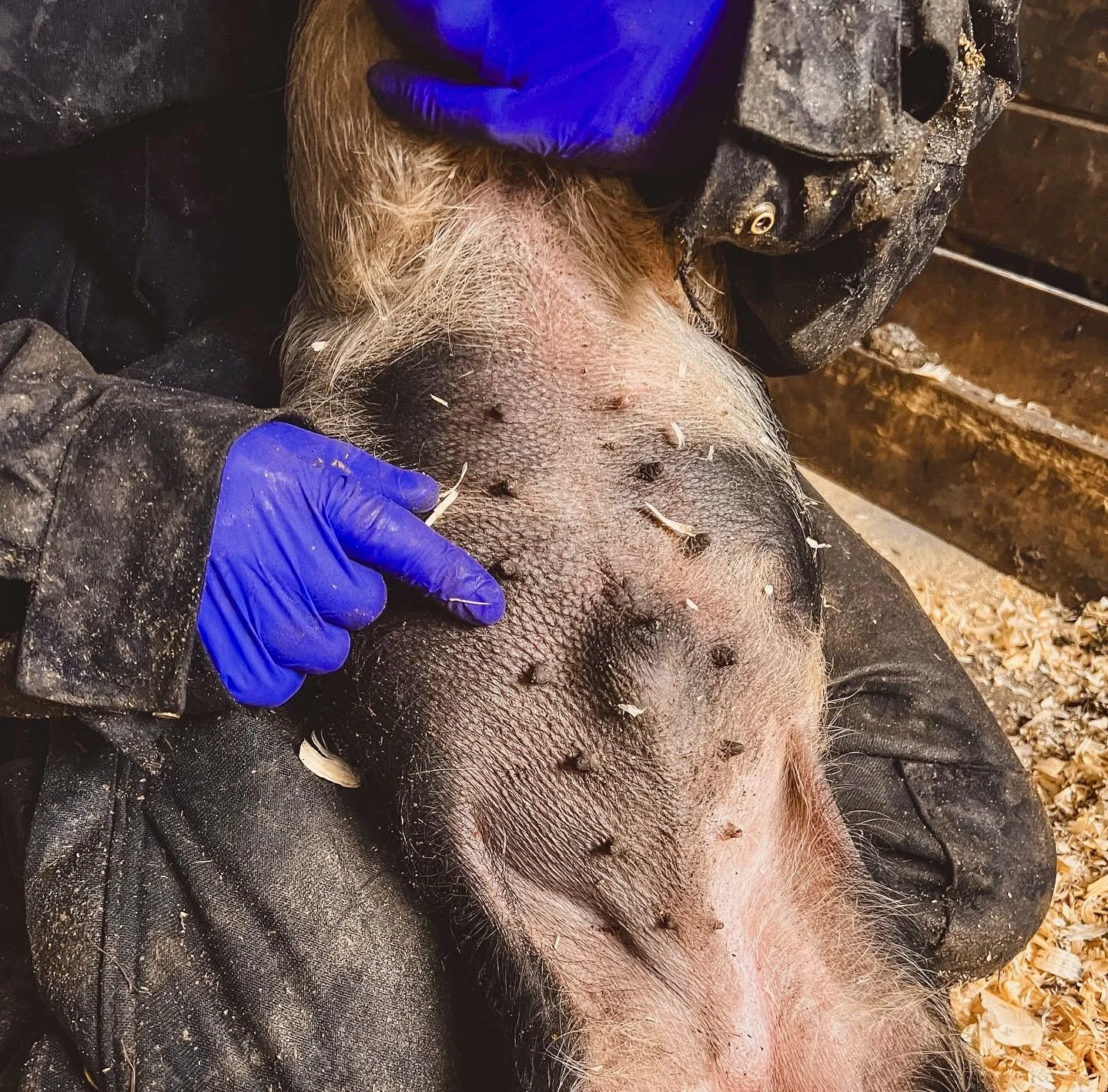
Underline
A well-structured underline is essential for both boars and sows/gilts to ensure effective nursing, reproductive success, and overall health. The APPS Standard of Excellence emphasizes proper teat structure, placement, and functionality as critical components of breeding stock evaluation.
Boars must have a minimum of 12 evenly spaced, well-formed teats, with at least 6 on each side (6x6). The goal is for breeding boars to exhibit 7 functional teats on each side (7x7), with 8 functional teats per side (8x8) representing exceptional quality. Teats should be prominent, evenly spaced from front to rear, and free from defects such as blind, pin, or inverted nipples. Functional teats are vital for passing on strong maternal traits. Boars with fewer than 12 functional teats or improperly spaced teats fail to meet the Standard, as their genetics could negatively affect the nursing abilities of future litters.
Sows/gilts must also have a minimum of 12 evenly spaced, functional teats, with at least 6 on each side (6x6). The goal is for sows/gilts to have 7x7 underlines, with 8x8 considered exceptional. Teats must be well-developed and properly spaced to ensure nursing accessibility for piglets. Proper placement from the front of the underline to the rear flank is crucial to support large litters and minimize competition during nursing. Blind, pin, or inverted nipples, or teats that are clustered or poorly spaced, are poor traits. A strong, well-formed underline allows sows/gilts to wean more piglets successfully while maintaining good body condition during lactation.
By the F4-F5 generation, underlines must not be uneven by more than one teat; for example, a 6x7, 7x8, or 8x9 underline is acceptable. More significant discrepancies indicate poor breeding potential and must be addressed.
Objections: APPs that fail to meet underline requirements—including fewer than 12 functional teats, fewer than 6 functional teats per side, defective nipples, improperly spaced teats, or structural udder defects—do not meet the Standard. While 6x6 is the minimum requirement, pigs failing to meet the breed goal of 7x7 or better after the F4-F5 generation should be re-evaluated for breeding. Such traits can reduce nursing capacity, litter performance, and overall productivity. APPs with these defects may need to be excluded from breeding programs to maintain the integrity and performance of the APP breed.
(Approved by the APPS on 1/1/25)
-

Disposition
Disposition refers to the temperament and behavioral traits of American Pasture Pigs (APPs), which are critical for both animal welfare and farm management. The APPS Standard of Excellence emphasizes the importance of a calm, friendly, and manageable disposition in both breeding stock and production animals. APPs are expected to exhibit a docile temperament that makes them suitable for a variety of farming environments, especially those focused on family and sustainable farming systems.
Boars, sows, and gilts should display a calm and non-aggressive nature, showing curiosity without fear and stress. A good disposition ensures that APPs are easy to handle, interact with, and manage during routine care, farrowing, and other farm tasks. Ideally, APPs will be confident and social, allowing for regular human interaction and minimizing stress-related behaviors that could negatively impact their overall health and productivity.
The ideal disposition for APPs should include calmness, social behavior, and manageability. APPs should not exhibit signs of excessive aggression or fear. They should respond to human presence with curiosity, not anxiety or defensiveness. Calm pigs are especially important during farrowing and daily management tasks. They should also be cooperative when handled and comfortable in groups. APPs should exhibit a natural herd instinct but be able to interact with humans without undue stress. Their behavior should make them easy to manage during breeding, farrowing, and general handling. Any pig that is excessively aggressive or overly skittish, and becomes difficult to handle, should be excluded from breeding programs.
APPs should also display a friendly disposition, showing signs of trust and willingness to engage with humans. While they are naturally independent, a willingness to engage with humans is highly desirable. A pig that resists human interaction, displays extreme fear, or behaves aggressively in response to handling or human presence does not meet the Standard of Excellence and should not be registered as an APP.
Objections: Pigs that exhibit aggressive tendencies, extreme fear, or unmanageable behaviors that make them difficult to handle or put other animals or humans at risk do not meet the breed standard. These behaviors can include excessive charging, skittishness, or extreme vocalization when approached. Such traits can negatively affect farm operations, animal welfare, and productivity. Any pig showing these behaviors should not be registered as an APP, as they do not meet the breed’s temperament requirements.
(Approved by the APPS on 1/1/25)
-

Condition
Condition refers to the overall health and physical appearance of American Pasture Pigs (APPs), which are critical indicators of their vitality and suitability for breeding or production. The APPS Standard of Excellence emphasizes the importance of maintaining a healthy, balanced condition to ensure long-term productivity, reproductive success, and overall well-being.
APPs should maintain a strong and healthy body condition that reflects proper management and good health. They should not be excessively fat or too thin, as either extreme can negatively impact their reproductive capabilities, growth, and overall longevity. An APP in ideal condition will demonstrate a healthy level of fat covering and muscle tone, which is necessary for both breeding success and efficient growth. Ideal condition also supports strong immune function, ensuring the pig is resilient to disease and able to thrive in diverse environments.
Boars should exhibit a firm, muscular build with adequate fat cover and a clear, defined shape. They should not be overweight or carry excessive fat, as this can affect their fertility and overall health. Maintaining a healthy body condition is essential for boars to perform their reproductive duties and to ensure their genetic potential is passed on to the next generation.
Sows and gilts should also display a healthy, solid body condition that supports reproductive performance. Sows should be well-maintained with visible muscle definition and a reasonable fat cover that reflects the nutritional management of the farm. Overly thin sows or those that appear excessively fat should be monitored closely, as these conditions can affect their ability to successfully farrow and raise healthy litters.
The condition of APPs serves as an indicator of effective farm management and nutrition. Proper care, feeding, and health management practices should ensure that all pigs maintain an optimal condition throughout their lifespan, contributing to their reproductive and productive success.
Objections: APPs that are overly thin, emaciated, or excessively fat do not meet the breed standard. These conditions can be a result of poor nutrition, improper management, or health issues that can reduce reproductive performance and overall productivity. Pigs consistently failing to meet the breed’s condition requirements, especially those showing signs of malnutrition or health problems, should not be considered suitable for breeding or registration as an APP. Maintaining optimal condition is essential to preserve the health and sustainability of the APP breed.
(Approved by the APPS on 1/1/25)
-
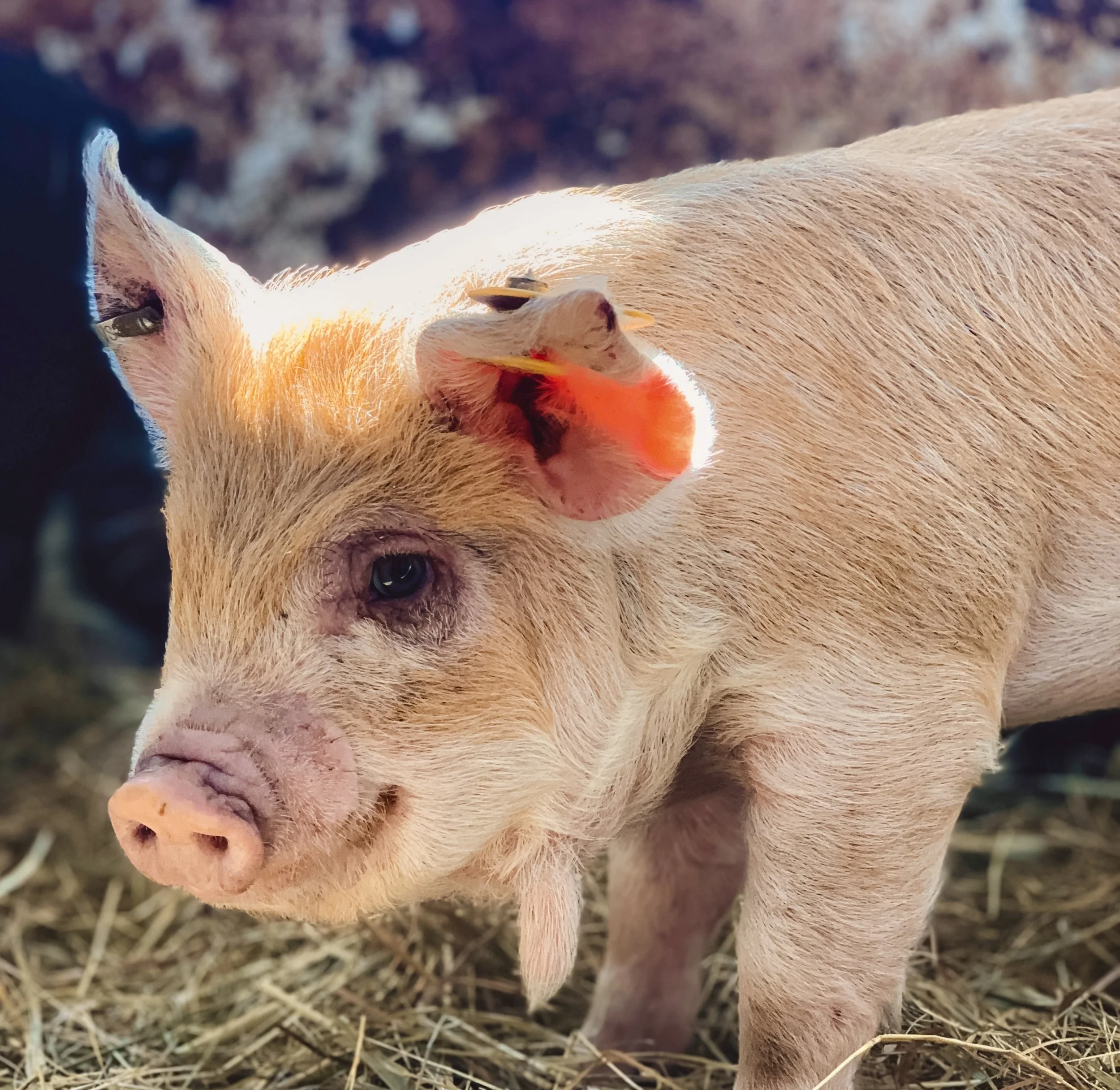
Wattles
Wattles, or fleshy appendages located on the neck of pigs, are a single-gene breed-identifying characteristic of American Pasture Pigs (APPs). While wattles are not a requirement for the breed, the presence of two well-formed, symmetrical wattles is strongly preferred as a distinctive trait that helps identify the breed. These wattles contribute to the breed’s unique appearance and are considered an important feature of APPs.
When present, wattles should be of moderate size, symmetrical, and positioned evenly on both sides of the neck. While wattles are strongly preferred, pigs without wattles, or only a single wattle, can still meet the Standard of Excellence as long as they conform to the breed’s other criteria.
The ideal APP will have two distinct, symmetrical wattles, as this helps maintain the breed’s characteristic look.
Objections: APPs with uneven, misshapen, poorly attached, or excessively large/small wattles are considered undesirable in terms of breed appearance. However, wattles are not a reason to exclude a pig from registration as an APP. APPs with wattles that do not meet ideal standards can still be registered as long as they meet the other criteria of the Standard of Excellence.
(Approved by the APPS on 1/1/25)
-
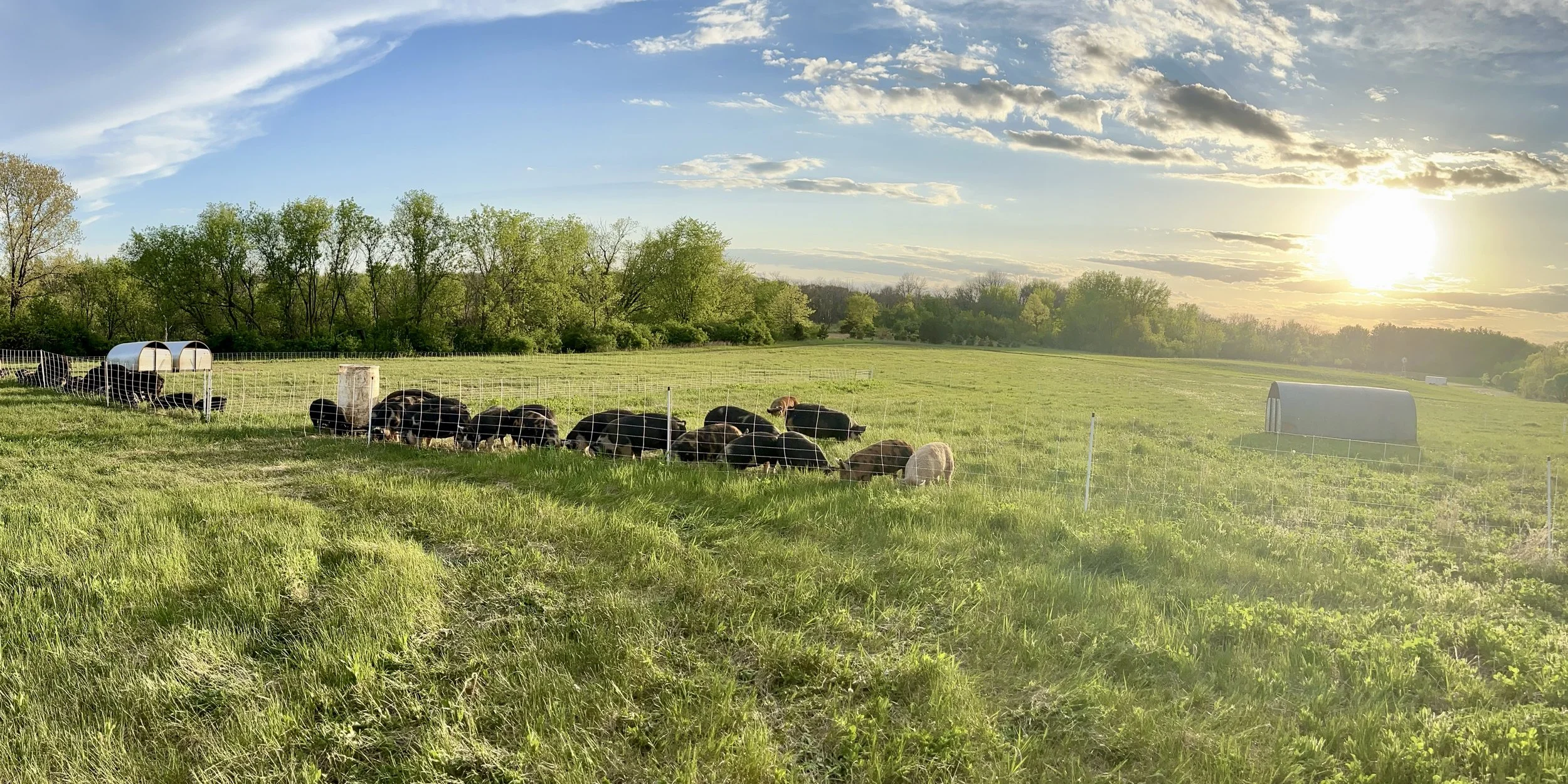
Grazing Ability
Grazing ability is a critical trait for American Pasture Pigs (APPs), as it reflects the breed’s suitability for sustainable, pasture-based farming systems. APPs are bred to graze, utilizing pasture and forage as a moderate portion of their diet.
The ideal APP will efficiently graze a variety of pasture plants and forage, including grasses, legumes, and natural browse. APPs are monogastrics, not ruminants and can not solely rely on pasture for all their nutritional needs, however, they should be able to graze effectively and contribute positively to their overall diet. During the winter or periods of limited pasture availability, hay becomes a vital supplement to ensure that pigs continue to receive enhanced nutrition. Good quality hay, such as grass or legume hay, helps provide fiber, nutrients, and protein when fresh forage is not available. APPs are expected to maintain good body condition with minimal reliance on supplemental grain or feed, particularly when pasture or hay is abundant.
APPs still root, as all pigs do, even when their mineral needs are met. Rooting behavior can be more pronounced if the ground has not been grazed before, if there are specific roots or grubs that attract the pigs, if the soil is soft from rain, or if they are not rotated frequently. Rooting may also increase when forage is sparse or if they are not given adequate space to roam. Sandy-type soils can also encourage more rooting behavior. However, when APPs have a nicely upturned snout, their rooting behavior tends to be less pronounced. Younger pigs tend to root more than mature stock as they are still developing their foraging instincts and behaviors.
APPs should exhibit calm and methodical grazing behavior, efficiently covering the pasture area and engaging with a variety of plant species. They should show a preference for grazing over rooting or destructive behavior, though some rooting is natural and beneficial for maintaining soil health. While some rooting is expected, it should not overshadow the breed’s ability to graze efficiently and forage in a way that is both productive and sustainable.
Objections: APPs that exhibit excessive rooting, damage to pasture, or other destructive behaviors that compromise pasture health and productivity are considered undesirable. While some rooting is natural, excessive or disruptive rooting should be addressed. APPs that show little interest in grazing, require excessive supplemental feed to maintain body condition, or do not efficiently utilize hay to support their diet fail to meet the breed standard for grazing ability. Additionally, APPs that do not contribute positively to pasture health or sustainability, such as those that root excessively in ways that damage the land, should be excluded from breeding programs to maintain the breed’s pasture-based qualities.
(Approved by the APPS on 1/1/25)
-
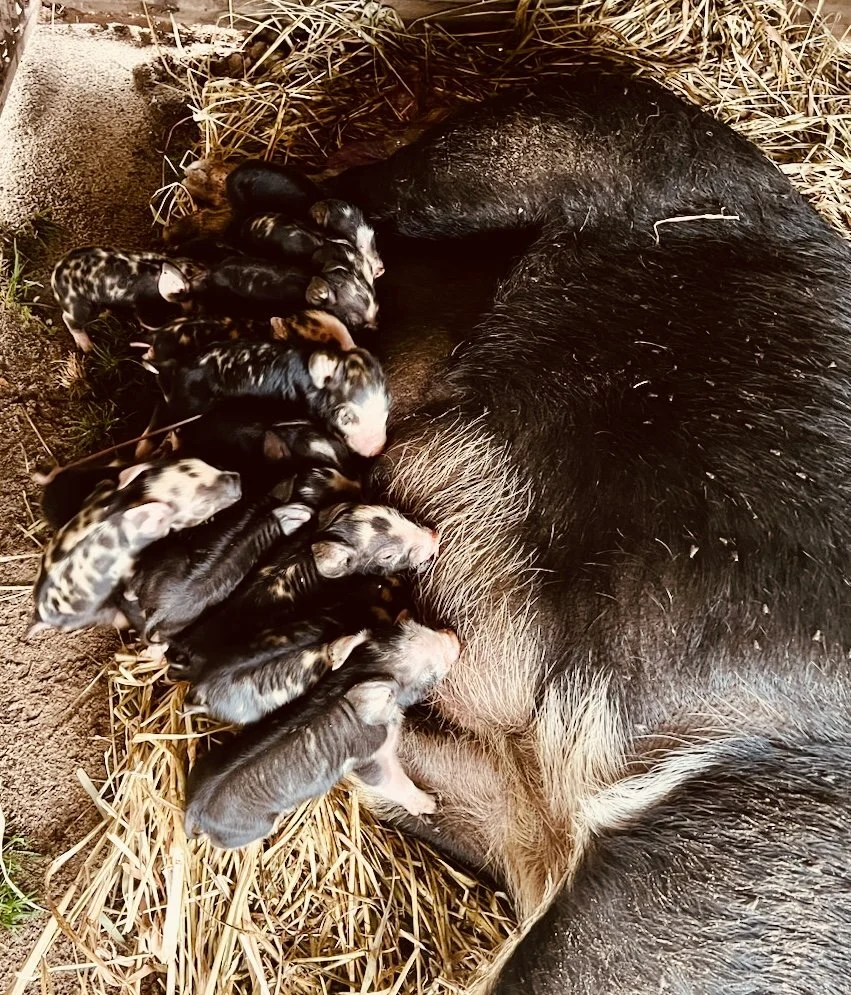
Litter Size
Litter size is a key indicator of maternal efficiency and productivity in American Pasture Pigs (APPs). The Standard of Excellence emphasizes that APP sows should consistently produce healthy, viable litters, with a primary focus on the sow’s ability to raise her piglets to weaning while maintaining good health and condition. The goal is for sows to produce litters with at least 10 viable piglets.
While APP sows have been known to produce litters as large as 16 piglets, the current target range for optimal litter size is 10 to 12 piglets. Larger litters are considered exceptional, as long as the sow can provide adequate care and milk to ensure that the majority of the piglets thrive and are successfully weaned. Sows that consistently produce fewer than 8 viable piglets should be closely evaluated for reproductive efficiency and maternal traits, as this is considered below the breed standard.
APP gilts should be assessed for their ability to produce healthy litters by their second or third farrowing. After this, there should be consistent performance in litter size, reflecting the breed’s potential for balanced productivity. Reproductive performance is a priority to ensure long-term sustainability within pasture-based farming systems.
Equally important is the sow’s ability to wean a significant portion of her litter. Strong maternal traits that allow a sow to successfully raise and wean healthy piglets are integral to the breed’s success. The number of piglets weaned, alongside the sow’s overall health during and after farrowing, should be prioritized in the breeding program.
Objections: Sows that consistently produce litters with fewer than 8 viable piglets, particularly over multiple farrowings, should be excluded from the breeding program. Occasional smaller litters may occur due to individual or environmental factors, but repeated low litter sizes below the minimum threshold should prompt a reevaluation of the sow’s genetic suitability. Additionally, sows that fail to wean a significant portion of their piglets or display signs of maternal neglect, poor health, or inability to maintain body condition throughout lactation should not be bred. These traits can negatively impact the breed’s sustainability, productivity, and overall profitability.
(Approved by the APPS on 1/1/25)
-
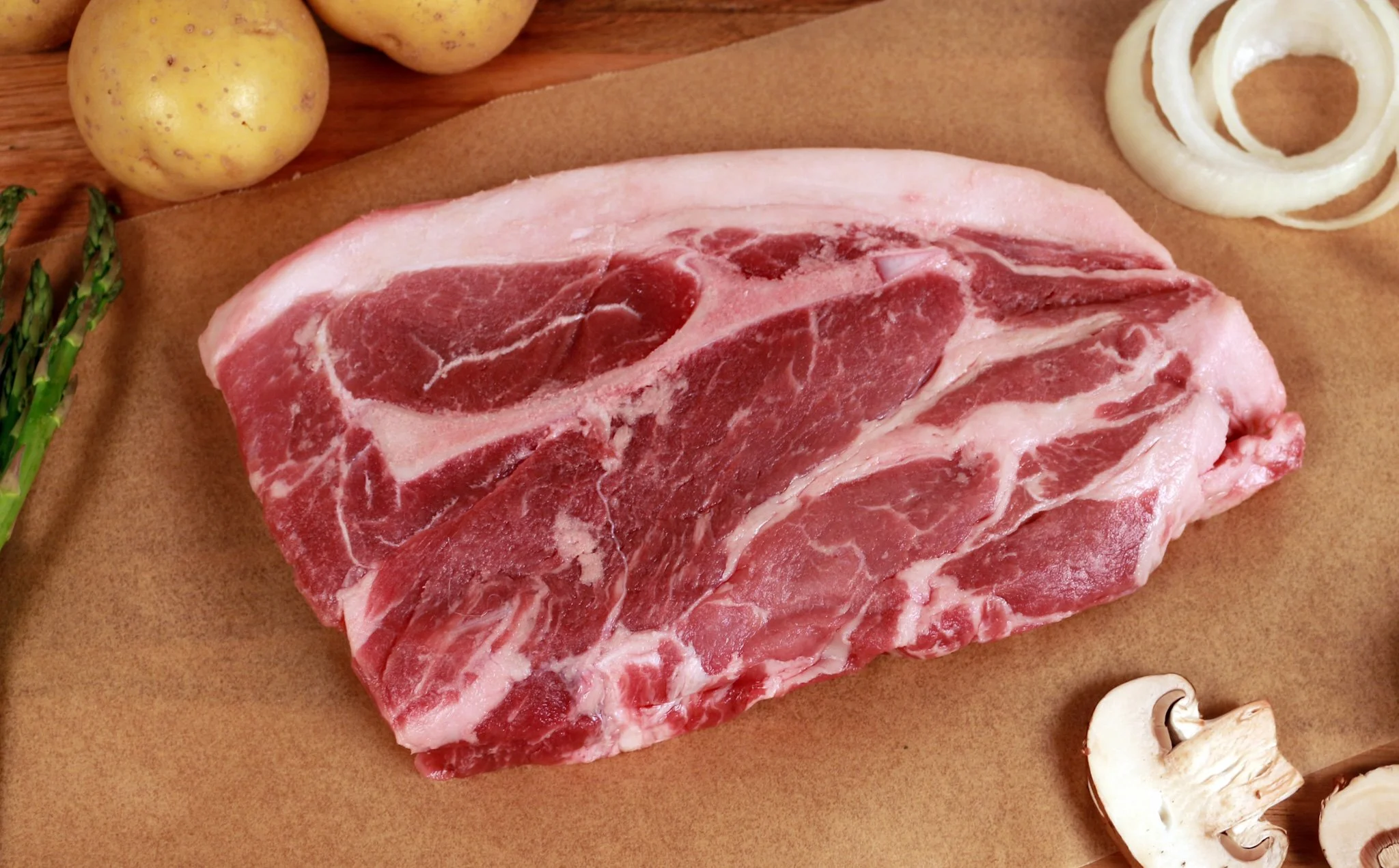
Carcass Quality
Carcass quality is a vital trait for the American Pasture Pig (APP) breed, influencing both marketability and consumer satisfaction. This section outlines the key attributes of pork quality, including color, pH, water holding capacity, marbling, and the role of modern technologies, such as ultrasound and Neogen’s genetic testing services, in enhancing meat quality.
Color: APP pork should have a rich, dark red color, which is indicative of good quality. This is measured using the Minolta L* scale, where a score between 42 and 46 is considered optimal. A Japanese color score of 3 to 5 also aligns with high-quality pork. Dark red meat is favored for its tenderness, flavor, and juiciness, all of which contribute to positive consumer experiences.
pH: The post-mortem pH of APP pork should range between 6.3 and 6.7, with an ultimate pH between 5.7 and 6.1 measured 24 hours post-slaughter. These pH levels ensure that the meat avoids issues like Pale, Soft, Exudative (PSE) or Dark, Firm, Dry (DFD), both of which negatively affect meat texture and consumer satisfaction.
Water Holding Capacity: Water holding capacity (WHC) is crucial to ensure that pork remains juicy and tender. Ideal APP pork should exhibit less than 5% drip loss and less than 25% cooking loss. This ensures optimal moisture retention during cooking, contributing to the desired texture and juiciness of the meat.
Marbling and Firmness: Marbling, or intramuscular fat, significantly impacts pork flavor and tenderness. For APP pork, the ideal marbling score is between 5 and 6. A marbling score within this range ensures the meat has enough fat for flavor enhancement without being excessive. The firmness of the meat should be between a score of 3 and 4, balancing tenderness and chewiness, which is essential for consumer enjoyment.
Ultrasound and Pork Quality: Ultrasound technology plays a pivotal role in assessing fat depth and lean muscle mass, both of which are important for determining meat yield and quality. By using ultrasound to evaluate fat distribution, producers can select pigs that are likely to have higher marbling and a better fat-to-muscle ratio, leading to improved meat quality. Ultrasound technology allows for non-invasive and accurate predictions, contributing to breeding decisions that optimize APP pork quality.
Neogen’s Genetic Testing Services for Pork Quality: Neogen’s genetic testing services provide valuable insights into traits that affect pork quality, such as marbling, fat depth, and overall muscle mass. These genetic markers enable breeders to select APPs with enhanced potential for superior meat quality, ensuring the highest standards of flavor, tenderness, and yield. Neogen’s testing helps to predict desirable traits early, allowing breeders to make informed decisions for improving the quality of future generations.
The APPS encourages breeders to take full advantage of these technologies, as ultrasound and Neogen’s genetic testing services can significantly enhance carcass quality by identifying superior traits for pork production. Using these services ensures that the breed’s carcass quality meets industry standards for consumer satisfaction while increasing profitability.
Profitability and Meat Yield: Carcass quality directly influences profitability. High-quality pork commands a premium price in the market. By using ultrasound to monitor fat depth and muscle mass and Neogen’s genetic testing to select for the best genetic traits, APP breeders can increase the chances of producing high-yield, high-quality APP pork. These technologies allow for better-informed breeding decisions, leading to enhanced carcass traits, greater meat quality, and improved farm sustainability.
By prioritizing these characteristics and utilizing modern tools like ultrasound and genetic testing, the APP breed can consistently meet the industry standards for pork quality, ensuring better consumer satisfaction and long-term profitability.
(Approved by the APPS on 1/1/25)